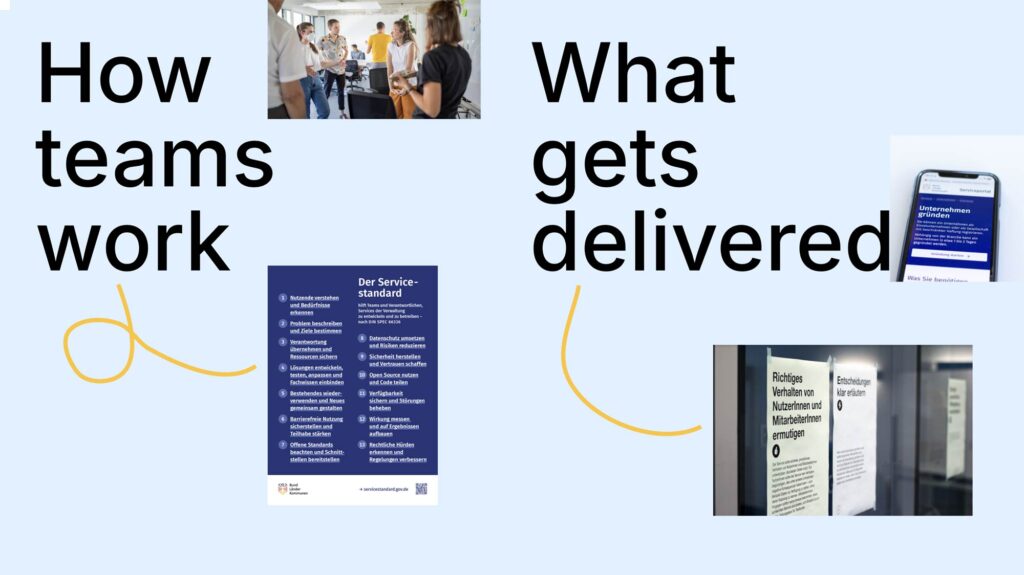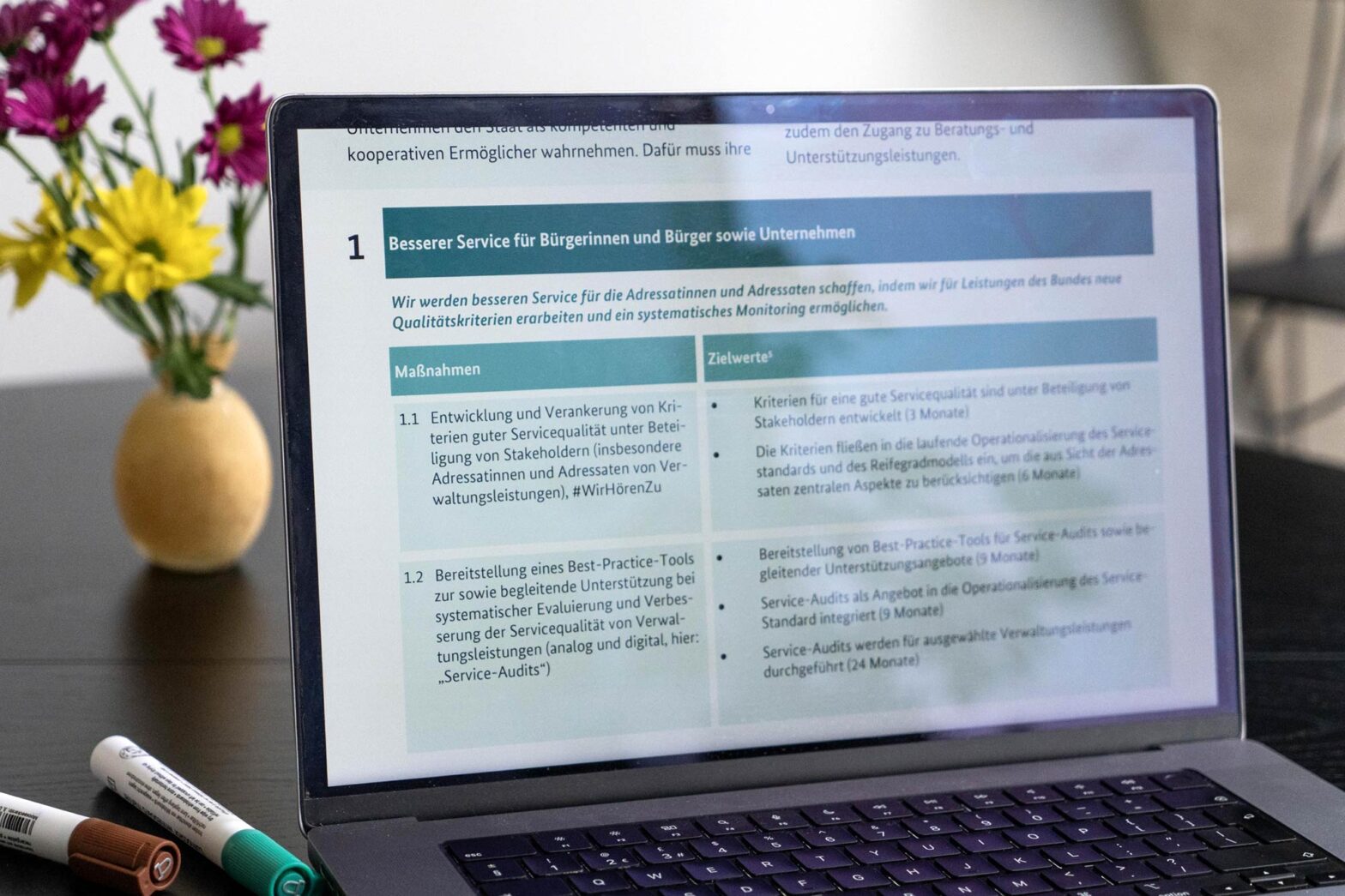Unfortunately, the quality of digital public services never really mattered. Senior leaders only cared if a thing was there. Not if it was any good. We heard that repeatedly. Last week, that changed in Germany.
As odd as it sounds, colleagues pitching improvements to vital services have been rebuffed and rejected. Money was already spent. Something was online. The box was ticked – no need to do more, at least for now.
However, bad services create a failure demand elsewhere. But often, that’s someone else’s problem. Not the same department and a different budget. We have learnt about numerous public services available online with dismal digital take-up rates.
Unpicking the modernisation agenda
A new policy paper aims to change that: Last week, the still new-ish Federal Ministry for Digital and Government Modernisation published its ‘modernisation agenda’. It outlines the ministry’s main modernisation efforts in 5 key areas of activity. One area is ‘citizen and business-centred service’.
The new digital ministry pledges that the government will create “digital, efficient and user-friendly services”. Previous strategies have done similar things. Plenty of regulations, position papers and coalition agreements used equal wording. This one goes further, though. While still lacking a larger vision, it states measures and sets targets.
Committing to defining service quality criteria
Involving service users and other stakeholders, criteria for good service quality will be developed, the paper states. They are ought to operationalise the Service Standard. This is an excellent development.
Australia’s NSW government has done similar things by creating measured ‘Customer Commitments’. They include promises like ‘Explain what to expect’ and ‘Respect [one’s] time’. Similarly, in the UK, hundreds of civil servants helped define characteristics of good services. My former boss, Lou Downe, wrote their book ‘Good Services’ about these. Content designer Louise Miller and I wrapped those characteristics into official guidance for the GOV.UK Service Manual incorporating the feedback of hundreds of people. And back at Public Service Lab Day 2018, we workshopped a German version of the service quality criteria. Some things come in circles, and I find that to be a good thing.
When looking at the relation of the UK Service Standard and the characteristics of good services, we had to sort things out. People asked us how the standard would relate to the characteristics. In a conversation with colleagues this week, I recapped that.
The Service Standard codifies how service teams should work when building services. The service quality criteria describe the attributes of what the service teams produce. Both are important; both matter.

Teams need to know how to progress and what the end goal should look like. Therefore, the Service Standard, as a way of working standard, and the service quality criteria must function as connected frameworks.
Running service audits and extending support offerings
The policy paper suggests systematically evaluating and improving service quality. This is supposed to include best practice tools and service audits.
We have seen a healthy head start in the past 2 years. Since summer 2023, 5 different public sector entities have been involved in Service Standard peer reviews. The resulting reports and documentation are openly available. Going forward, the established peer review format can be an excellent springboard for a more formalised auditing process. Again, much can be learnt from Australia and the UK, where 100s of service assessments have been run.
It’s still a long path to better outcomes for users, but I am genuinely excited about these helpful efforts and shifting views on service quality. I don’t fully understand how these proposed initiatives tie into our current work, but I hope to make sense of it in the coming days.
Drafting Q4 priorities and writing narratives
Early in the week, we reviewed the priorities for the Service Standard team for the rest of the year. Just under 3 months until the year finishes – minus Christmas and the holidays, and it’s closer to 2 months. Hence, we need to slice and dice things realistically.
Writing guidance, helping teams write in-practice accounts, shaping how formal audits are conducted, and communicating widely are what’s on the list. Unsurprisingly, this aligns closely with what’s openly stated in the published route map.
Later in the week, I helped service designer Lena review points on static vs. flexible branding. Currently, there are 2 legitimate ways to use the Eagle brand mark of the digital umbrella brand. Service teams can use it in its templated way. Then, it says ‘Bund Länder Kommunen’ (‘Federal government, states, municipalities’) next to the eagle. Or they can put their service name. There were pros and cons to both of these approaches. Lena and I started unpicking them on a whiteboard a few days ago. She continued working on and shaped a clearer narrative. I helped her tweak it. I went as far back as my 2009 thesis work on flexible branding, which I dusted off from the bookshelf.
What’s next
I will try to make sense of the modernisation agenda further and its set objectives.
On Thursday, I will have to travel to Dessau – of Bauhaus fame – to attend the next meeting of the Digital Council of the State of Saxony-Anhalt. It’s been a while since I’ve been to Dessau. Unfortunately, I won’t have much time to visit the newly opened Bauhaus museum there. The reason for that: Digital Service is celebrating its 5th birthday on the same evening. I don’t want to miss that, of course.

